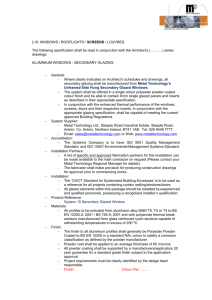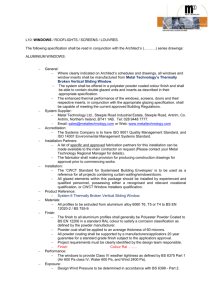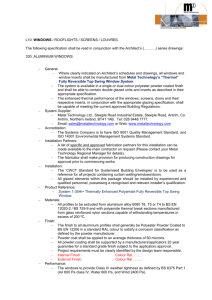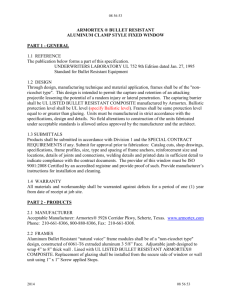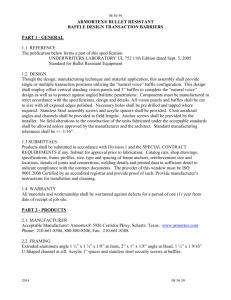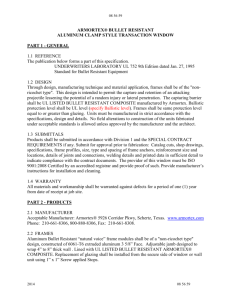TGD-021-1 - Department of Education and Skills
advertisement
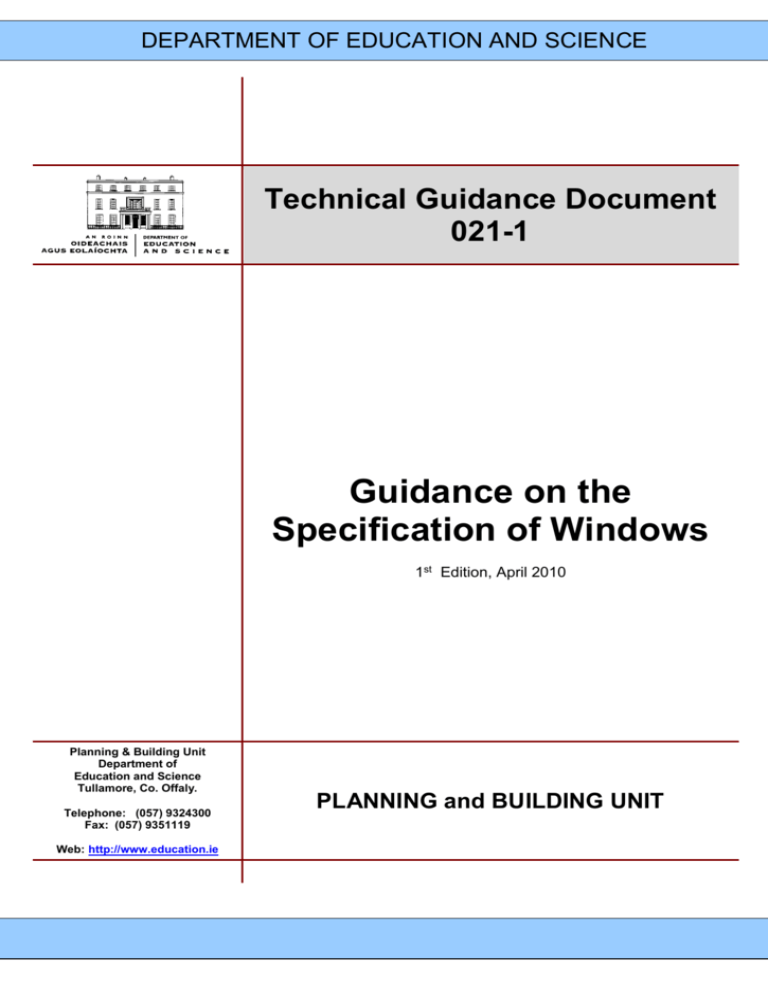
DEPARTMENT OF EDUCATION AND SCIENCE Technical Guidance Document 021-1 Guidance on the Specification of Windows 1st Edition, April 2010 Planning & Building Unit Department of Education and Science Tullamore, Co. Offaly. Telephone: (057) 9324300 Fax: (057) 9351119 Web: http://www.education.ie PLANNING and BUILDING UNIT Guidance on the Specification of Windows 1st Edition, April 2010 CONTENTS 1. INTRODUCTION 1.1 1.2 1.3 1.4 2. 3. 5. 7 ALUMINIUM ............................................................................................................................. 7 TIMBER ................................................................................................................................... 7 UNPLASTICIZED POLYVINYL CHLORIDE (PVC-U) ....................................................................... 8 REINFORCEMENT .................................................................................................................... 8 THERMALLY IMPROVED FRAMES ............................................................................................... 9 FRAME JOINT SEALING MATERIALS ............................................................................................ 9 BEARING DEVICES AND HARDWARE........................................................................................... 9 HARDWARE ............................................................................................................................. 9 HINGES, STAYS AND PIVOTS ..................................................................................................... 9 BALANCES FOR VERTICALLY SLIDING WINDOWS ......................................................................... 9 WEATHERSTRIPPING: ............................................................................................................ 10 GLAZING GASKETS ................................................................................................................ 10 FIXINGS ................................................................................................................................ 10 GLAZING MATERIALS: ............................................................................................................. 11 DESIGN AND CONSTRUCTION 4.1 4.2 4.3 4.4 4.5 4.6 4.7 4.8 4.9 4.10 4.11 4.12 11 WORK SIZES AND MANUFACTURING TOLERANCES................................................................... 11 OPERATION........................................................................................................................... 12 MARKING .............................................................................................................................. 12 WEATHER-TIGHTNESS ........................................................................................................... 12 VENTILATION OF ROOM DIRECT TO EXTERNAL AIR .................................................................... 12 DESIGN FOR GLAZING ............................................................................................................ 13 OPENABLE WINDOWS............................................................................................................. 13 REMOTE WINDOW OPENING DEVICES ...................................................................................... 13 FRAME JOINTS ...................................................................................................................... 13 GLAZING LIGHT TRANSMITTANCE FACTOR ................................................................................ 14 GLASS AND GLAZING ............................................................................................................. 14 SECURITY ............................................................................................................................. 15 APPENDIX 1 5.1 5 GENERAL ................................................................................................................................ 5 INDEPENDENT ACCREDITATION ................................................................................................. 5 PRODUCT DATA: ..................................................................................................................... 6 SHOP DRAWINGS: ................................................................................................................... 6 SITE DIMENSIONS: ................................................................................................................... 6 SAMPLES: ............................................................................................................................... 6 CONTRACT CLOSEOUT: ........................................................................................................... 6 HANDLING ............................................................................................................................... 6 MATERIALS: 3.1 3.2 3.3 3.4 3.5 3.6 3.7 3.8 3.9 3.10 3.11 3.12 3.13 3.14 4. APPLICATION........................................................................................................................... 3 GENERAL PERFORMANCE REQUIREMENTS ................................................................................ 3 TENDER OPTIONS ................................................................................................................... 4 FURTHER INFORMATION ........................................................................................................... 4 COMPLIANCE REQUIREMENTS 2.1 2.2 2.3 2.4 2.5 2.6 2.7 2.8 3 16 GLOSSARY OF TERMS............................................................................................................ 16 Department of Education and Science, Planning and Building Unit Pg 2 of 16 Guidance on the Specification of Windows 1st Edition, April 2010 1. INTRODUCTION 1.1 1.2 Application (a) These Guidelines state the minimum standards to be used in the design and specification of new or replacement windows for use in educational facilities and should be read in conjunction with other relevant design guidance, available at www.education.ie under Technical Guidance. These guidelines do not set out the standard required for existing windows. (b) These standards apply to all Primary and Post-primary construction projects funded in part or in whole by the Department of Education and Science including Summer Works projects and Devolved Grants. (c) Notwithstanding the above, it will remain the responsibility of the designer to ensure that any window installation is fit for purpose and complies with the relevant I.S., EN and B.S. Standards. Designers should also be aware of and take into account the requirements of the current Building Regulations. General Performance requirements (a) Windows must have a design life span of 40 years. (b) A good quality daylight distribution is required in each room with the average day lighting factor for each room to be in the range 4.5 to 5.5% with the emphasis on an even light distribution throughout the space. A schedule of all rooms and associated daylight factor is to be provided. In calculating the above daylight factor the computer area and the area 700mm in front of the storage wall/ cloaks (if provided) may be excluded. (c) In the case of a window replacement project where it is not possible to meet the full requirements of this specification (e.g. Daylight Factor) designers should maximise the potential of the existing openings. (d) All spaces should have the benefit of 1/3 high and 2/3 low level natural ventilation opening sections in the windows. Tilt and turn windows are not appropriate. The ventilation and window design with respect to geometry and opening sections must be based on overheating calculations with computational modelling taking into account the “g” value for the glazing unit which should take into account the air tightness standard. Adequate natural ventilation should be achievable without draughts. (e) It is a requirement that window ventilators be eliminated from all window units where possible. They should only be provided where there is no alternative option for passive ventilation. Preference should be given to controllable wall ventilation. Controlled background ventilation openings to comply with the building regulations should be provided in addition to any sash openings. (f) If rooms must be north facing due to site restrictions efforts should be made to achieve solar penetration to the rooms. (g) Blinds to classroom windows shall be manually operated chain driven roller system units with light coloured dense basket weave sunscreen material with a 5% openness factor (50% visible light transmission). Materials used in the manufacture of the blinds should meet the designation of 'flameproof' when Department of Education and Science, Planning and Building Unit Pg 3 of 16 Guidance on the Specification of Windows 1st Edition, April 2010 assessed in accordance with BS 3120: 1959. A test certificate as in appendix 'C' of "fire safety of furnishings and fittings in places of assembly" should be supplied for each item specified. (h) 1.3 The provision of blinds is not and must not be included in window replacement projects. Tender Options (a) Tenders should be sought for one of the following options only: (i) (ii) (iii) 1.4 Supply and fit of aluminium alloy windows are to be in accordance with BS4873: 2009 Specification for Aluminium Alloy Windows. Supply and fit of Timber windows are to be in accordance with BS 644:2009 specification for fully finished factory-assembled windows of various types. Supply and fit of unplasticized polyvinyl chloride (PVC-U) windows are to be in accordance with BS 7412:2007 Specification for windows and door sets made from unplasticized polyvinyl chloride (PVC-U) extruded hollow profiles. (b) The window supplier shall submit evidence that the windows offered conform to the standard. (c) The operation and strength characteristics of opening lights shall be in accordance with BS 6375 Part 2. Further information (a) If further information or assistance is required in relation to this Document please refer to the Professional and Technical Section of the Department of Education and Science Ph: +353 (0)57 9324300 Department of Education and Science, Planning and Building Unit Pg 4 of 16 Guidance on the Specification of Windows 1st Edition, April 2010 2. COMPLIANCE REQUIREMENTS 2.1 2.2 General (a) All windows proposed for use in educational facilities must conform to this specification. It will be the responsibility of the Window Manufacturer to provide independent accredited test report conforming to this specification to the project supervisor prior to the selection of any proposed window system. The minimum requirements are set out in Table 1. (b) Where an independent test report cannot be produced or validated for the criteria in this specification the proposed window system will not be approved for use. Independent accreditation (a) The contractor is required to submit independent accredited approval from the manufacturer of the selected/proposed window system to comply with the following Department of Education and Science product requirements; Reference EN 12207:2000 Air Permeability BS EN 12208:2000 Water tightness IS EN 12211: 2000 Wind Resistance BS 8200 Design of nonloadbearing external vertical enclosures of buildings BS EN ISO 140 Acoustic Performance Thermal Transmittance I.S. EN ISO 100771:2006 Glazing to BS 62621:2005 EN12206-1 2004 BS EN 1670: 1998 Building Hardware. Corrosion resistance. Requirement and test method DOES Requirements Class 3 at 600Pa. or better. Test Class 9A at 600Pa. or better. P1= 1600Pa., P2 = 800Pa., P3 = 2400Pa. All windows and doors to comply with requirements of this standard. The Rw sound reduction index for the Glazing should not be less than 27db. Table F.4 — Thermal transmittances for vertical windows with fraction of the frame area 20 % of the whole window area, glazing spacer bars with improved thermal performance 1.8 W/m²°K. Design size: 1.2wide x 1.5m high top hung opening sash full size. Manufacturer to provide documentary evidence that the above sized window has a thermal performance of 1.8 W/m²°K or better. Glazing to conform to the guidelines set out in this standard. Thermal transmittance for standard glazing shall be no greater than - 1.2 W/m²K = Centre pane U value. All units to be 24/28mm in thickness Typical centre pane make up: 4mm glazing – 16mm argon filled cavity (90%) – 4mm soft coat thermal glazing. Where safety glazing is required the supplier shall submit calculations to show an overall U-value of 1.2 W/m²K. The spacer used to separate the glazing should be a warm edge spacer bar and the space between the panes filled with Argon gas. A minimum requirement for the U-value of the glazing for a window Design size: 1.2wide x 1.5m high top hung opening sash full size shall be 1.8W/m²K Polyester Powder coating Interpon D or Syntapulvin applied by Qualicoat approved applicator using a standard RAL colour in matt finish. All Ironmongery to comply with the requirements this standard. Multipoint single lever locking system is to be incorporated in all opening sashes. Table 1 – Submittal / Design Statements Department of Education and Science, Planning and Building Unit Pg 5 of 16 Guidance on the Specification of Windows 1st Edition, April 2010 2.3 Product Data: (a) 2.4 Shop Drawings: (a) 2.5 Manufacturer to provide upon request; sized to represent material adequately. Contract Closeout: (a) 2.8 The dimensions provided on the tender documents are indicative and should only be used for pricing. It is the Contractor's responsibility to produce the dimensions with which the windows will be manufactured to. Samples: (a) 2.7 The contractor is required to submit to the project supervisor profiles, accessories, location, and dimensions. Site Dimensions: (a) 2.6 The contractor is required to submit to the project supervisor manufacturer’s product data for all materials in this specification. The contractor is required to submit to the project supervisor the window manufacturer’s warranty prior to the contract closeout. Handling (a) NOTE 1 Window types and examples of handing are shown in Figure C.1 and Figure C.2 of BS4873:2009. These handing illustrations show the traditional British designations. The forthcoming European designations (pr EN 125194)) are significantly different and shall be applied on its’ release. (b) NOTE 2: The handing of a multi-light or a horizontally sliding window is related to the position of the largest opening light. (c) NOTE 3: The handing of a vertically pivoted window is described by the position of the pivots in relation to the opening out portion. (d) The handing shall be in accordance with the tender drawings provided. (e) In specifying the handing all windows shall be viewed from the outside unless otherwise stated. (f) For a multi-light window, the arrangement of the multi-light shall be shown on a diagram. (g) The handing of side-hung, top-hung and bottom-hung casements is related to the position of the hinges. (h) The proportion opening outwards of a vertically pivoted window shall be stated. Department of Education and Science, Planning and Building Unit Pg 6 of 16 Guidance on the Specification of Windows 1st Edition, April 2010 3. MATERIALS: 3.1 Aluminium (a) Extruded aluminium profiles shall be fabricated from designated treated alloy 6060 or 6063 in tempers T4, T5 or T6 conforming to BS EN 755-9:2001. (b) When ancillary components such as sills, couplings etc. are formed from sheet materials they shall be fabricated from designated alloys 1200, 3103, 5005 or 5251 conforming to BS EN 485-2:1995 in temper suitable for the particular type of application and degree of forming to be adopted. (c) The aluminium profiles used in the construction of the frames excluding glazing beads, nibs, interlocks and similar features shall be, at minimum tolerance, not less than 1.2 mm thick. (d) Powder Coated Finish (i) (ii) (iii) (iv) 3.2 The aluminium shall be finished with the following: A powder coating conforming to BS EN 12206-1:2004: ‘Paints and varnishes Coating of aluminium and aluminium alloys for architectural purposes’ Polyester Powder Coating A Polyester Powder coating Interpon D or Syntapulvin (Not a mixture of both) applied by Qualicoat approved applicator using a standard RAL colour in matt finish to EN12206-1 (2004). Prior to the application of the polyester power coating the aluminium profiles are to be pretreated using an 8-stage process of acid etching, Chrome or Chrome Free process to Qualicoat approval and water rinsing. A guarantee of 25 years must be applied for in advance of starting the project on site. It is noted that this period of time is subject to the location or proximity of the school to marine environment. Therefore ‘Architectural powder coating to Qualicoat ‘Seaside’ standard from approved supplier’ is required. Timber (a) All of the timber used in the manufacture of windows for Educational Facilities should be sourced from an approved sustainable source. (b) Quality (i) (ii) (c) Timber shall be of a species classified as suitable for its purpose in accordance with BS EN 942:2007, National Annex NA. The timber for window frames, casements and sashes shall be of the classes defined for the UK in BS EN 14220, or better. NOTE: Where for reasons of design or appearance a higher quality of timber is required, the specifier should discuss these special requirements with the manufacturer in respect of timber species and availability. Preservation (i) (ii) (iii) (iv) The wood or wood-based components of a window shall either have sufficient natural durability, or be preservative treated. NOTE 1: The sapwood of any species will require preservative treatment. The natural durability of wood or wood-based components of a window to be used without preservative treatment shall be at least durability class 3 as defined in BS EN 350-2:1994. NOTE 2 If it is desired to use a species not listed in BS EN 350-2, its durability can be established in accordance with BS EN 350-1. Department of Education and Science, Planning and Building Unit Pg 7 of 16 Guidance on the Specification of Windows 1st Edition, April 2010 Where the natural durability of the wood is class 4 or class 5 as defined in BS EN 350-2:1994, or where sapwood is present: (vi) a) For preservatives assessed under BS EN 599-1 for penetrating processes and other preservatives listed in BS 8417 as suitable for Use Class 3 (as defined in BS EN 335-1:2006), the wood shall be preservative treated in accordance with BS 8417 (Use Class 3.1, 30-year life); (vii) b) For preservatives assessed under BS EN 599-1 for superficial processes, the wood shall be preservative treated using a preservative with a critical value (CV) derived from BS EN 599-1:1997 3), Use Class 3 (with coating), including testing to BS EN 330, in which the preservative shall be applied using the manufacturer’s proposed method of application and the reference preservative shall be applied by double vacuum. The treatment shall achieve penetration class P1 (BS EN 3511:2007) and a retention of CV (factor × 1.5). (viii) Any component or part of a component that is machined in a manner that exposes untreated timber shall receive further treatment to ensure continuity of the preservative envelope. (ix) NOTE 3: The long-term performance of a window depends not only on the maintenance of the preservative envelope but on the maintenance of the window as a whole. (v) 3.3 3.4 Unplasticized Polyvinyl Chloride (PVC-U) (a) White PVC-U extruded hollow profiles used in plastics windows and door sets shall conform to BS EN 12608. (b) Surface covered PVC-U extruded hollow profiles used in plastics windows and door sets shall conform to BS 7722 (c) PVC-U profiles manufactured in accordance with BS EN 12608 only require an occasional wipe down for appearance purposes. A gradual loss of gloss might occur over time which has no effect on the functional performance of the window. As PVC-U profiles have been successfully used for windows and door sets for the last 40 years, PVC-U windows and door sets manufactured in accordance with this British Standard are expected to last in excess of 40 years. Reinforcement (a) The use of reinforcement in plastics windows and door sets shall conform to the recommendations in British Plastics Federation publication 323/1. (b) NOTE 1: Reinforcement should be non-hygroscopic and should have no adverse effect on the performance of the window or door. Where metal reinforcement is used it shall be manufactured from one of the following metals: (c) a) Mild steel sheet, hot-dip zinc coated, conforming to BS EN 10327:2004, coating designation Z275. This type of reinforcement shall only be used in profiles or systems designed and sealed so that no exterior moisture can come into contact with the reinforcement; (d) b) Mild steel sections which are subsequently given a corrosion resistant coating in order to conform to the requirements in a). This type of reinforcement shall only be used in profiles or systems designed and sealed so that no exterior moisture can come into contact with the reinforcement; (e) c) Austenitic stainless steel sheet or strip conforming to BS EN 10088-2; (f) NOTE 2: This type of reinforcement can be used in any type of profile or system. Department of Education and Science, Planning and Building Unit Pg 8 of 16 Guidance on the Specification of Windows 1st Edition, April 2010 3.5 3.6 3.7 3.8 (g) d) Extruded aluminium alloy conforming to BS EN 485-2, BS EN 515, or BS EN 755-9. (h) NOTE 3: This type of reinforcement can be used in any type of profile or system. Thermally improved frames (a) Where window frames are thermally improved by the inclusion of an insulating barrier or cladding, the insulating material should be stable under the conditions of service, e.g. under wind and dead loads and within the likely surface temperature range of the frames. The thermal barrier or cladding system should be sufficiently robust to withstand tests carried out in accordance with BS 6375-1: 2009 and BS 6375-2: 2009. (b) NOTE 1 BS 6375 specifies performance requirements for the strength of windows based on a series of mechanical tests that check the integrity of the frame. (c) NOTE 2 Requirements for thermal barriers are specified in prEN 140243). Frame joint sealing materials (a) When the completed window is tested in accordance with BS 6375-1 and BS 6375-2, there shall be no degradation of the sealing or the operational function of the window due to failure of the sealing materials. (b) NOTE Materials should be able to withstand stresses during assembly, transportation, installation and operation of the window. Bearing devices and hardware (a) Metallic materials used for bearing devices and hardware shall have at least the equivalent corrosion resistance to BS EN 1670:1998, class 3 when subjected to a neutral salt spray test as specified in BS EN 1670. (b) NOTE 1: For environments in very polluted localities such as those subject to combinations of industrial and coastal pollution, BS EN 1670:1998, class 4 should be used. (c) NOTE 2 Requirements for hardware materials are specified in pr EN 131261). These requirements apply to both metallic and non-metallic materials. Hardware (a) 3.9 Hinges, stays and pivots (a) 3.10 Where non-metallic components are incorporated, the material and specification for these should be selected according to the required function. Friction hinges, variable geometry stays and friction pivots are expected to maintain friction without adjustment or, when adjustment devices are provided, with adjustment. Corrosion test reports to be submitted. Balances for vertically sliding windows (a) Balance mechanisms are available in too many types and styles for this standard to specify materials, finishes and means of attachment to frames and sashes. However, it is most important that the window design, including the provision of stops where required, is such that the balances can be fitted in a manner Department of Education and Science, Planning and Building Unit Pg 9 of 16 Guidance on the Specification of Windows 1st Edition, April 2010 approved by the balance supplier. Balances should be ordered to the correct length and weight for the glazed-sash including an allowance for friction. 3.11 3.12 Weatherstripping: (a) Weatherstripping shall be one of the following: (b) Ethylene propylene diene monomer (epdm); or (c) Plasticized PVC (PVC-P); or (d) Polychloroprene (CR); or (e) Polypropylene pile; or (f) Sheathed cellular elastomeric polymer; or (g) Silicone (Si); or (h) Thermoplastic elastomer (TPE). (i) NOTE 1 Non-cellular forms of materials a), b) and c) are specified in BS 4255-1. (j) NOTE 2 Guidance on weatherstripping products is given in BPF WG 345/1 [1]. Glazing gaskets (a) To minimise gaps in joints and shrinkage internal gaskets are to be serrated to allow for the gasket to be continuous and not requiring mitre jointing at corners. The internal gaskets are to have one joint only which is to be sealed and located at a low critical area. (b) Glazing gaskets shall be one of the following: Chloroprene rubber, solid (cellular); or Chloroprene rubber, solid (non-cellular) conforming to BS 4255-1; or (iii) Cured ethylene propylene diene monomer (epdm); or (iv) Plasticized PVC; or (v) NOTE 2 Plasticized PVC gaskets should not be used with polycarbonate glazing materials. (vi) e) PVC nitrile; or (vii) f) Thermoplastic elastomer (TPE); or (viii) g) Uncured ethylene propylene diene monomer (epdm). (ix) Glazing compounds shall be non-setting compounds, preformed mastic tapes, gun grade solvent release (x) Type sealants, one-part or two-part curing sealants or two-part rubberizing compounds. Gun grade sealants (xi) Shall conform to BS ISO 11600. (i) (ii) 3.13 Fixings (a) All straps, clips, brackets, lugs, screws, nuts, bolts, rivets, metal washers, shims and other fixings shall be manufactured from one of the following: stainless steel grade A2, A4 or F1 conforming to BS EN ISO 3506-1:1998 or BS EN ISO 35062:1998; steel which has been finished by one of the following methods: zinc plating in accordance with BS EN 12329:2000, code Fe/Zn 12 or Fe/Zn 25, and chromate passivation in accordance with BS 6338:1982, class 2C or 2D; hot dip galvanizing in accordance with BS EN ISO 1461 to a minimum coating mass of 460 g/m2; Department of Education and Science, Planning and Building Unit Pg 10 of 16 Guidance on the Specification of Windows 1st Edition, April 2010 spraying with a zinc coating in accordance with BS EN 22063:1994, symbol Zn4; any other protective treatment of equivalent performance to those specified in 1) to 3); aluminium, of an alloy having mechanical strength properties at least equal to that of the frame. 3.14 (b) NOTE Spacer shims used at fixings, which serve only as packing and do not influence the structural integrity of the fixing, may be of extruded or moulded plastics material. (c) Fixing devices should be capable of withstanding the design wind load (see BS 6399-2) and any operating forces of the windows. Provision should also be made to prevent water penetrating any holes provided for the fixings. Glazing materials: (a) Glazing type and thickness shall be selected, using the recommendations given in BS 6262, to withstand the design wind pressure calculated in accordance with BS 6375-1 or BS 6399-2. The type and quality of glass shall conform to BS 952-1. (b) The exposed edges of glass adjustable louver blades shall be arrised, ground or polished. (c) Insulating glass units shall conform to BS 5713. (d) NOTE 1 A series of standards specifying requirements and test methods for glass, prEN 1279, is currently in preparation. (e) Work sizes and manufacturing tolerances: (f) Work sizes (g) The work sizes for overall length and height shall be documented. The site survey of the windows will be the responsibility of the window contractor and comply with BS 8213-4:2007, Windows, doors and roof lights – Part 4: Code of practice for the survey and installation of windows and external doorsteps. (h) Manufacturing tolerances (i) The size of an assembled frame shall be within ±1.5 mm of the documented work size in any dimension, and the difference between the diagonals of the assembled frame shall be not more than 4 mm. 4. DESIGN AND CONSTRUCTION 4.1 Work Sizes and Manufacturing Tolerances (a) The work sizes for overall length and height shall be documented. The site survey of the windows will be the responsibility of the window contractor and comply with BS 8213-4:2007, Windows, doors and roof lights – Part 4: Code of practice for the survey and installation of windows and external doorsteps. (b) The size of an assembled frame shall be within ±1.5 mm of the documented work size in any dimension, and the difference between the diagonals of the assembled frame shall be not more than 4 mm. Department of Education and Science, Planning and Building Unit Pg 11 of 16 Guidance on the Specification of Windows 1st Edition, April 2010 4.2 Operation (a) 4.3 Marking (a) 4.4 4.5 The completed window shall conform to the performance requirements for operation and strength specified in BS 6375-2. Pre manufactured window components shall be marked or labelled with: The name or trade mark of the manufacturer; the number and date of the British Standard, i.e. the relevant standard for the appropriate material used to construct the window. Weather-tightness (a) The following weather-tightness requirements apply to all types of window. (b) The completed window shall meet the weather-tightness requirements for the appropriate classification specified in BS 6375-1, when tested in accordance with BS 6375-1 and, for double windows, with the appropriate additional procedure given below. (c) For air permeability, double windows shall be tested with both windows closed, the length of opening joint being that which is visible on the inner surface of the inner window only. (d) For water-tightness, double windows shall be tested with both windows closed and the performance class shall be that obtained by the outer windows. (e) For wind resistance, double windows shall be tested with the inner window open and the outer window closed. The test shall then be repeated with the inner window closed and, if the outer window contains opening light(s), this (they) shall be opened. Ventilation of room direct to external air (a) Each window assembly must be manufactured in accordance with Part F Table 1 Ventilation of room direct to external air of the current Building Regulations and achieve a minimum rapid ventilation area of 1/20th of the floor area of the room. The selected fabricator must demonstrate compliance through calculations mentioned earlier. (b) The following criteria should be used for background ventilation: (i) (ii) Floor area up to 10 m2 - 6500 mm2 Floor area over 10 m2 - 650 mm2/m2 of floor area (c) Window ventilators are only to be provided where no alternative means of passive ventilation can be provided. Designers are required to provide controllable passive wall ventilators where necessary. Wall vents should be of a high control standard and be capable of completely turned off (Hit and Miss is not acceptable) (d) Where indicated on window schedule, each window shall incorporate a Ventilator and shall be polyester powder coated offering a single colour facility to match the window profiles. They should be fitted with an external, aluminium hood. The glazed in vents should be fitted with rod control. (e) Each vent must be capable of providing a minimum free airflow in accordance with Part F of the current Building Regulations. Vents shall be tested to BS6375 Part 1 Department of Education and Science, Planning and Building Unit Pg 12 of 16 Guidance on the Specification of Windows 1st Edition, April 2010 1989, and achieve the same requirements of the window unit for purposes of Air permeability, water tightness and wind resistance. 4.6 Design for glazing (a) The frame design shall be such that: (i) (ii) (iii) (iv) (v) 4.7 4.8 4.9 The glazing shall comply with current Building Regulations; The window can be glazed in accordance with BS 6262; Re-glazing is possible without the need to remove the outer frame from the structure of the building; It is possible to renew the weatherstripping without removing the outer frame from the structure of the building; It is possible to replace the hardware without removing the outer frame from the structure of the building. Openable windows (a) For windows that are intended to be openable, the opening sashes however designed shall move freely and smoothly without hindrance throughout their intended range of movement. (b) The range shall be restricted to an opening for child safety and to ensure adequate free openable area. (c) In horizontally and vertically sliding windows, adjacent aluminium members shall not slide upon each other. (d) In horizontally sliding windows, the sashes shall be supported on bearing devices that facilitate movement and prevent direct contact between the sashes and the aluminium tracks. (e) In vertically sliding windows, the mechanism or balancing device shall be accessible for adjustment, repair or replacement, after the windows have been installed. Remote window opening devices (a) Where opening window that are considered to be unreachable (refer to tender document) they shall be fitted with manual winding window gearing. Each set of windows shall be controlled by 1 No. operator; windows shall be opened using 250mm chain openers with conduit, winder cables and saddle fixings to wall. All components shall be finished in a selected polyester powder coated paint finish. As per window schedule. (b) Where indicated on drawings, the windows shall be controlled by chain operated actuators with 230V motors with reverse polarity for open/close operation, and should have automatic limit switching between 90mm and 400mm, effective stroke distance of high-level windows to ensure adequate free openable area. Frame joints (a) Joints in frames shall be made either by welding or by mechanical means (e.g. cleating and screwing) and shall have flush, stepped or lapped surfaces. For flush joints formed by mechanical means, any deviation from the same plane shall be within the limits set by the use of extrusion tolerances given in BS EN 755-9. Department of Education and Science, Planning and Building Unit Pg 13 of 16 Guidance on the Specification of Windows 1st Edition, April 2010 (b) Welded joints shall be cleaned off smooth on surfaces that are exposed when the window is in the closed position and where the joints would otherwise project into the glazing space. (c) Sealing of joints (i) (ii) (iii) 4.10 4.11 Any frame joints, including those of the thermal barrier or cladding, which would otherwise cause loss of watertightness and/or increase of air permeability, should be sealed with sealant or by other means to achieve the performance required. Deviations in the plane of flush joints No allowance is given for assembly and machining tolerances. Therefore, to achieve the requirements specified it can be necessary to use extrusions with closer tolerances than those given in BS EN 755-9. In practice, to avoid sharp exposed edges etc., manufacturers might need to agree tolerances with the extrusion supplier. It can be necessary to fit “L” shaping backing plates (chevrons) to flanges of mitred cornered frames to correct misalignment due to angular tolerances. Glazing light transmittance factor (a) The total solar transmittance of the window shall comply with the requirements of BS 6262-2:2005 Glazing for buildings —Part 2: Code of practice for energy, light and sound. (b) The glazing light transmittance factor shall comply with the requirements of BS 8206-2:2008 Lighting for buildings –Part 2: Code of practice for day lighting. (c) NOTE: The accessible parts of finished windows should as far as reasonably practicable be free from all sharp edges, burrs etc. Glass and Glazing (a) Windows shall be glazed in accordance with the recommendations given in BS 6262. (b) NOTE: Attention is drawn to the glazing safety recommendations of BS 6262-4. (c) 24mm/28mm double glazed units, low “E” argon filled (90%) glazing units. Safety glass to be 6.8mm laminated to BS 6262 & BS 6201- Glass in Buildings. All glazing must be installed in accordance with BS 6262 and the double glazed unit manufacturer’s and system supplier’s instructions. (d) To comply with BS 5713, hermetically sealed and Kite mark certified. (e) All windows shall contain sealed units, which shall be manufactured in accordance with EN1279 Parts 2 and 3 and carry the necessary and appropriate guarantee. (f) The glazing light transmittance factor shall not be less than 70% (g) Clerestory high-level windows to have sandblasted finish to Face 2 of doubleglazed units to reduce glare (GP Halls). (h) U-value: Design size: 1.2wide x 1.5m high top hung opening sash full size. Manufacturer to provide documentary evidence that the above sized window has a thermal performance of 1.8 W/m2°K or better. The centre pane “U” Value of each sealed unit when combined with the window frame should achieve a target figure of 1.8Wm²/K when treated a single element. Each fabricator/installer must demonstrate compliant glass choice with tender return. All glazing shall conform to BS 6262. Use thermally broken warm edge spacer in the double glazed units to increase thermal efficiencies. All glazing to be Low E Hermetically Argon Filled Department of Education and Science, Planning and Building Unit Pg 14 of 16 Guidance on the Specification of Windows 1st Edition, April 2010 double glazed Clear sealed units 4/16/4mm to BS 5713:1979 with a U value ≤ 1.2 W/M²K 4.12 (i) Any perimeter taping must be transparent to permit inspection of unit edge condition. (j) Glazing System: All double-glazed units, panels and inserts shall be supported continuously along all four edges by specialised glazing support blocks. All windows shall be dry glazed using external ‘snap in’ extruded aluminium beads with captive ‘E’ gaskets externally and wedge gasket internally. The corners of the gaskets shall be accurately mitred together and sealed to ensure an effective joint. Setting blocks and location pieces shall be fitted in accordance with BS 6262 in order to ensure the windows are maintained square and rigid. Security (a) When the completed window is tested in accordance with BS 7950:1997, A.4 and A.5.1, it shall not be possible to gain entry. (b) NOTE 1: The manufacturer should establish whether any of the security devices listed in Annex B is to be provided. (c) NOTE 2: A glazing system that prevents the removal of the glass by dismantling the system entirely from the outside is available as an optional feature (see Annex B). (d) NOTE 3: Guidance for security against crime is given in BS 8220. (e) Handles shall suit single lever wrap around multipoint locking type. The opening is to be restricted for child safety and to ensure adequate free openable area. To meet the required security level and safety standard all lower opening vent frames shall be fitted with one non releasable locking restrictor. These will restrict the window opening in line with the rapid ventilation calculations. These should be fitted in accordance with manufacturer’s recommendations and as detailed in their technical literature. Department of Education and Science, Planning and Building Unit Pg 15 of 16 Guidance on the Specification of Windows 1st Edition, April 2010 5. Appendix 1 5.1 Glossary of Terms (a) Aluminium alloy window: window incorporating aluminium alloy framing members and glazing rebates. (b) Bearing device: wheel, roller, skid or other device fitted at the head or sill of a horizontally sliding window to support the weight of the sash and to facilitate movement. (c) Casement: window, or part of a window, which opens on hinges, pivots or variable geometry stays. (d) Coupled window: glazed frame with another glazed frame hinged or fastened to it, so that both open together for ventilation and can be separated for cleaning purposes. (e) Design wind pressure: wind pressure that can be expected on a surface of a building having taken into account the Sa, Sd and Sb factors and the shape of the building by applying pressure coefficients to the dynamic pressure of the wind. NOTE See BS 6399-2. (f) Double window: two separate glazed frames superimposed in the same wall opening. (g) Fixing: an item that is used to secure separate members of a window assembly to each other, to secure an item of hardware to a window member, or to secure a completed window assembly into the structure of a building. (h) Glazing gasket: plastics or synthetic rubber member, used between the glass and the frame and/or the glass and the bead. (i) Hardware: fitting attached to a window that is used to operate and/or secure it. (j) Insulating glass unit: two or more panes of glass manufactured to size and shape, spaced apart and then hermetically sealed in a factory, ready for glazing. (k) Multi-light window: window incorporating opening and/or fixed lights within one perimeter frame. (l) Sash: movable frame of a horizontally or vertically sliding window (m) Secondary window: window either fitted into the same wall opening as an existing window, or applied to an existing window, to provide improved thermal and/or sound insulation (n) Thermally improved frame: frame of an aluminium alloy window that incorporates an insulating material to improve the thermal performance NOTE: It may be of the thermal barrier type, where the inner and outer faces are separated by the insulating material. (o) Weathertightness: performance in respect of air permeability, watertightness and wind resistance. (p) Weatherstripping: material around opening lights to reduce air and/or water penetration. Department of Education and Science, Planning and Building Unit Pg 16 of 16
